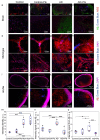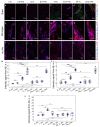Plasmalogens Improve Lymphatic Clearance of Amyloid Beta from Mouse Brain and Cognitive Functions
- PMID: 39684263
- PMCID: PMC11640916
- DOI: 10.3390/ijms252312552
Plasmalogens Improve Lymphatic Clearance of Amyloid Beta from Mouse Brain and Cognitive Functions
Abstract
Amyloid beta (Aβ) is a neuronal metabolic product that plays an important role in maintaining brain homeostasis. Normally, intensive brain Aβ formation is accompanied by its effective lymphatic removal. However, the excessive accumulation of brain Aβ is observed with age and during the development of Alzheimer's disease (AD) leading to cognitive impairment and memory deficits. There is emerging evidence that plasmalogens (Pls), as one of the key brain lipids, may be beneficial for AD and cognitive aging. Here, we studied the effects of Pls on cognitive functions and the lymphatic clearance of Aβ from the brain of AD mice and mice of different ages. The results showed that Pls effectively reduce brain Aβ levels and facilitate learning in aged but not old mice. In AD mice, Pls improve the lymphatic clearance of Aβ that is accompanied by an increase in general motor activity and an improvement of the emotional status and learning ability. Thus, these findings suggest that Pls could be a promising candidate for the alternative or concomitant therapy of AD and age-related brain diseases to enhance the lymphatic clearance of Aβ from the brain and cognitive functions.
Keywords: Alzheimer’s disease; age; amyloid beta; cognitive functions; lymphatic clearance; plasmalogens.
Conflict of interest statement
The authors declare no conflicts of interest.
Figures





Similar articles
-
Amyloid-β plaque formation and reactive gliosis are required for induction of cognitive deficits in App knock-in mouse models of Alzheimer's disease.BMC Neurosci. 2019 Mar 20;20(1):13. doi: 10.1186/s12868-019-0496-6. BMC Neurosci. 2019. PMID: 30894120 Free PMC article.
-
Isorhynchophylline ameliorates cognitive impairment via modulating amyloid pathology, tau hyperphosphorylation and neuroinflammation: Studies in a transgenic mouse model of Alzheimer's disease.Brain Behav Immun. 2019 Nov;82:264-278. doi: 10.1016/j.bbi.2019.08.194. Epub 2019 Aug 30. Brain Behav Immun. 2019. PMID: 31476414
-
Berberine Improves Cognitive Impairment by Simultaneously Impacting Cerebral Blood Flow and β-Amyloid Accumulation in an APP/tau/PS1 Mouse Model of Alzheimer's Disease.Cells. 2021 May 11;10(5):1161. doi: 10.3390/cells10051161. Cells. 2021. PMID: 34064687 Free PMC article.
-
Beneficial Effects of Walnuts on Cognition and Brain Health.Nutrients. 2020 Feb 20;12(2):550. doi: 10.3390/nu12020550. Nutrients. 2020. PMID: 32093220 Free PMC article. Review.
-
Plasmalogens and Alzheimer's disease: a review.Lipids Health Dis. 2019 Apr 16;18(1):100. doi: 10.1186/s12944-019-1044-1. Lipids Health Dis. 2019. PMID: 30992016 Free PMC article. Review.
Cited by
-
Age as a limiting factor for effectiveness of photostimulation of brain drainage and cognitive functions.Front Optoelectron. 2025 Mar 31;18(1):6. doi: 10.1007/s12200-025-00149-3. Front Optoelectron. 2025. PMID: 40163163 Free PMC article.
References
MeSH terms
Substances
Grants and funding
LinkOut - more resources
Full Text Sources
Medical

